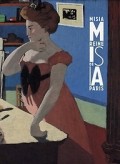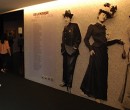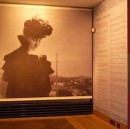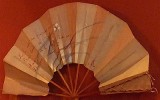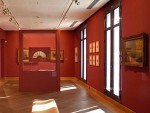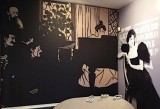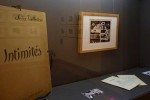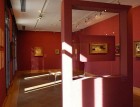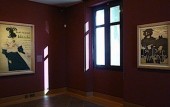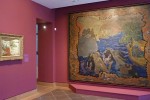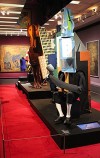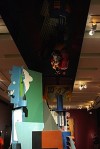The browser will either open the file, download it, or display a dialog.
Misia: Queen of Paris
Musée d’Orsay, Paris
June 12–September 9, 2012
Musée Bonnard, Le Cannet, France
October 13, 2012–January 6, 2013
Catalogue:
Misia: Reine de Paris.
Editor Isabelle Cahn, with contributions by Claude Arnaud, Guy Cogeval, Isabelle Cahn, Mathias Auclair, Martine Kaufmann, and short essays by Mathias Chivot, Emmanuel Coquery, and Marie Robert.
Paris: Editions Gallimard and Musée d’Orsay, 2012.
192 pp.; 93 color illustrations; chronology of Misia’s life; list of works in exhibition; selected bibliography.
35 €
ISBN: 9-782070-138197
Misia (Maria Sophie Olga Zenajda Godebska Natanson Edwards Sert) (1872–1950) has deservedly been placed in the center of a recent exhibition at the Musée d’Orsay and the Musée Bonnard (fig. 1).[1] For those familiar with the influence and patronage of Misia, an exhibition celebrating her life and the artists she inspired has been long overdue.[2] The aim of this exhibition was to combine stimulating biography with a rich variety of objects to better understand a person integral to avant-garde art in its many forms; the curators should be heartily congratulated on their success at creating a multidisciplinary study of the many touchstones of Misia’s artistic influence. The exhibition excels at presenting a variety of media: paintings, photographs, drawings, posters, film, costumes, books, and correspondence.
The catalogue and exhibition itself also exemplify one of the issues that occur when studying such powerful tastemakers, whether they be patrons, muses, advisors, or some combination of these roles, and that issue is one of biographical accuracy. Much of Misia’s history is based on her autobiography or rumors whose origination is difficult, if not impossible, to determine. Therefore, one must necessarily question how much of her known biography is accurate when it is based largely on her own perceptions and writings. Arthur Gold and Robert Fizdale’s highly readable biography of Misia similarly requires complete trust by the reader as it is absent of any citations. To the degree that it is possible, one wishes that the catalogue had clarified more of the reasoning behind its acceptance of Misia’s seemingly embellished stories. Further research into the truthfulness of the biography of Misia is a worthwhile pursuit. [3]
As tastemaker, muse, and advisor, Misia supported and inspired artists, writers, musicians, and performers in Paris and beyond. Called the Queen of Paris during her lifetime, she was an influential socialite, continuing a tradition in France of charming women who would gather intellectuals during weekly salons in their homes, and stoke the fires of creativity and inspiration. She was married to three influential men: Thadée Natanson (1868–1951), a Polish businessman and journalist; Alfred Edwards (1856–1914), the owner of several newspapers, the Théâtre de Paris and Casino de Paris; and the Spanish painter José María Sert (1874–1945). Much of her power derived from the men in her life, and the role she played as the conduit to these men. Yet she deftly played this role and created her own power through her enchanting yet, at times, fierce character.
The Musée d’Orsay’s exhibition space was essentially a very long and wide hallway, broken into subsections by partitions and artworks placed in the center of the aisle; an intimate rather than crowded effect was created by being surrounded by so many artworks in a seemingly tight space. One additional room at the end of the exhibition contained large cases of documentation, some video clips, and an area to purchase souvenirs. The Musée d’Orsay demonstrated Misia’s support of, and engagement with, the arts throughout her life, from her musical connections to Gabriel Fauré and Franz Liszt, to her intimate relationships with the circle of the Nabis, to her support of the theater and the ballet, to her enduring friendships with Sergei Diaghilev (1872–1929) and Coco Chanel (1883–1971).
The Musée Bonnard, an appropriate venue not only because of Misia’s close relationship with Bonnard, but also because of her time spent in the south of France, was spread throughout several light-filled rooms, as opposed to the darker and windowless setting of the Parisian museum. Rather than presenting the phases of Misia’s life in such equal proportion, the Musée Bonnard devoted over half of its space to Misia’s early life in the circle of La Revue Blanche (her first husband’s avant-garde journal) in which she became close with many Nabis artists. Generally, however, the organization of the two exhibitions was chronological, with artworks presented on walls of puttied plums, burnt oranges, and rich burgundies.
At the entrance to both exhibitions, one is greeted by oversized photographs of Misia in various guises: innocent, coquettish, lounging, pouting, even dressed as a man (figs. 2 and 3). Her compelling chronology is posted, but her family of origin is understated in comparison to the rest of her life, perhaps because of a lack of visual material. It is relevant to understanding Misia’s talent and support of the arts to know her background as the daughter of the famous Polish sculptor Cyprien Godebski (1835–1909) (one of whose sculptures could have been displayed), and granddaughter of Belgian cellist Adrien-François Servais (1807–66), whose cello is considered one of the finest in the world and now resides in the Smithsonian.[4] Misia’s dramatic childhood accounts for aspects of her psychology, according to her autobiography; most notably the fact that her very pregnant mother travelled thousands of miles in the Russian winter to be with her husband, only to find him with his mistress. [5] The next day, Misia’s mother died giving birth to her, and she was raised by her father and his mistress.
Misia grew up in a house filled with music; as a child she studied under Gabriel Fauré (1845–1924) and Franz Liszt (1811–86), the former shed tears when he heard of Misia’s engagement to Thadée Natanson, because he knew she would no longer become a career pianist. The musical aspect of Misia’s aura was emphasized in the first part of the exhibition with numerous artworks showing her in the act of playing, and with the particularly exquisite note of prominently displaying the Symbolist poet Stéphane Mallarmé’s (1842–98) gift to Misia, a fan upon which the following poem was elegantly penned beneath a painterly flourish (figs. 4 and 5).
Unfolding wing of paper
Flutter fully, if not long ago
You were initiated by Misia
To the storm and the joy of her piano[6]
The beginnings of both exhibitions highlight the years of her marriage to Thadée (1893–1904), the publisher of the Symbolist journal, La Revue Blanche. Misia became the touch point for all those who wanted access to Thadée, yet she also became close friends with several painters, including Edouard Vuillard (1868–1940), Pierre Bonnard (1867–1947), Henri de Toulouse-Lautrec (1864–1901), and Félix Vallotton (1865–1925). It was surely a challenge for curators when making selections from the hundreds of works by the Nabis artists that either portrayed Misia and Thadée or were financed by them.
Vallotton, affectionately called “Vallo” by Misia, was given special prominence as the artist of the painting, Misia at Her Dressing Table (1897), selected for promotions and the catalogue cover (figs. 1 and 6). In this small-scaled treasure owned by the Musée d’Orsay, the statuesque form of Misia dominates the scene, overpowering the flattened objects behind her. Her pointed nose creates a perfectly vertical line linking and contrasting the rectilinear objects on the wall with the curvature of her body and clothing, particularly her large black bow and the anatomically impossible twisting of her arms. The precise delineation between objects recalls the medium of the woodcut, one of which is shown on the wall, for which Vallotton was well known. One important woodcut by Vallotton, The Symphony (1897, Bibliothèque Nationale de France, Paris) was displayed near this painting; it portrays Misia (all in white) playing behind a solid black piano (fig. 7). Decorative patterns from flowers and the wallpaper surround her. To the left are several of her admirers, listening intently; most noticeably, Vuillard stands scratching his beard with his eyes closed.
At both locales of the Misia exhibition, Vallotton’s woodcuts were positioned adjacent to the main exhibition in a nearby small space. The room contained the ten black and white scenes from the Intimistes series (1877–78, Bibliothèque Nationale de France, Paris), depictions of lovers commissioned by La Revue Blanche (fig. 8). Alongside Vallotton’s series hung Denis Savory’s reinterpretation of these scenes from 2007 in which the artist sliced off sections from the original images that contained faces (whom Savory identifies as Misia); the ten newly created prints (minus the rectangular sections that were sliced), and one collage of all ten slices, creates possible reinterpretations as to the fate of the lovers; perhaps they have been violently separated, their love torn apart (fig. 9).
Scholars have often suggested that Edouard Vuillard was infatuated with Misia, which she discusses in her memoir:
Vuillard wanted to take a last walk along the banks of the Yonne, and we started at dusk. Looking dreamy and grave, he led me beside the river amongst the tall birches with their silvery trunks…I fell in with his mood . . . The ground was rough, I tripped on a root and almost fell; Vuillard stopped abruptly to help me regain my balance. Our eyes met. In the deepening shadows I could see the sad gleam of his glance. He burst into sobs. It was the most beautiful declaration of love ever made to me…Dear Vuillard, I have always treasured in my heart the memory of our walk in the beetroot field.[7]
In Vuillard’s journal entry from Christmas Eve, 1896, he writes, “Thadée and his wife a very good time. Tenderness, desires of work, ambitions and sensualities…home at four in the morning, slept until noon. Uncertainty and conflicting desires. An abundance of memories.”[8] We may never know the extent of Vuillard’s feelings for Misia, and the leading scholar on Vuillard, Guy Cogeval, argues that, “it is not so important whether there was more than tenderness between the painter and his muse,” but that often paintings by Vuillard in the late 1890s were, “conditioned by the imprint in space of her passing.”[9]
Vuillard’s enchantment with Misia is apparent in his numerous representations of her. Of the hundreds of paintings and photographs from which to choose, an impressive thirty-eight images by Vuillard were selected for one or both venues. Thirteen were photographs, ten were portraits of Misia (or scenes of which she is a part), and two were sketches of her. Hung noticeably in the center of the room in both exhibitions is a sensuous painting of Misia’s neck, as if the painter desperately wished to caress it with his own hands (figs. 10 and 11). Vuillard’s Cipa Listening to Misia at the Piano (1897–98, Staatliche Kunsthalle, Karlsruhe) vibrantly shows the music emanating from the piano, and becoming one with the objects and patterns in the room. The still stance of Misia’s brother, Cipa, contrasts with the busy rhythm of the wallpaper, which surrounds her and the piano. Misia is further linked to her background by the tall lamp that stands upon the piano but seems part of the painting (also by Vuillard) hanging on the wallpaper.[10] Elizabeth Easton’s insightful study on Vuillard, an unfortunate oversight in the bibliography for this catalogue, devotes a chapter to the musicality in images of Misia, and comments that "music is not physically depicted but psychologically evoked in the Symbolist manner."[11] The musicality that surrounded Misia and filled the space around her was something artists felt compelled to portray in images of her.
Misia was the inspiration and often the model for artworks produced by La Revue Blanche; for example, the two posters, one by Toulouse-Lautrec and one by Bonnard, which promoted the journal(fig. 12). It is hoped that this exhibition will spark further studies that focus on the art produced at La Revue Blanche, Misia’s role within the Nabis group, and Vuillard’s artworks of Misia.[12] A particularly compelling inclusion that shows the integral role Misia played within the avant-garde group is a page from Bonnard’s Life of a Painter (1910).[13] In the central scene of this page, Bonnard recalls the atmosphere at the offices of La Revue Blanche. On the right, two of the Natanson brothers are conversing on a project. Félix Fénéon (1861–1944) is shown bent over his desk writing while Octave Mirbeau (1848–1917), in his coat and mustache, discusses a project with a colleague. Most prominently, on the far left of the scene is a sketch of a fashionable and sensuous Misia, shown either as a figure walking in the door or as a framed fashion plate. In this male world of the journal, Misia’s presence is markedly emphasized.
According to Misia in her autobiography, her marriage with Thadée ended because he offered her to Alfred Edwards in exchange for protection from going bankrupt. This dissolution of Misia and Thadée’s marriage became legend, even inspiring the play Le Foyer (Charity) by Thadée and Octave Mirbeau (1848–1917) in which the main protagonist, after some unethical economic choices, needs his wife to approach her former lover for financial help.[14] From Misia’s point of view she married her second husband largely to protect her first, and simply because she felt she had no better options; like much of Misia’s autobiography, this interpretation probably has strains of both truth and fiction. Her new role as Mrs. Edwards positioned her well both financially and socially. Misia remained close to Bonnard and Pierre-August Renoir (1841–1919) throughout her turbulent divorce from Thadée and marriage to Alfred Edwards. In the summer of 1906, Bonnard accompanied the newlyweds on their yacht (named Aimée after Misia’s initials), where the artist took several photographs and painted scenes of the yacht and the couple. During her time as Mrs. Edwards, Bonnard frequently painted her as an object d’art, displaying her in rich, luxurious surroundings, but never involved in any activity, as she had most often been in portrayals for the Natanson period. In the 1908 portrait selected for this exhibition, Misia is displayed like a doll, hair in an enormous bun, posed on a settee with cleavage revealed (even portrayed in the nude in Bonnard’s preparatory sketches), and most notably without a smile.[15]
In 1906, Misia Edwards commissioned Bonnard to paint four large panels for her extravagant home; two of these panels are owned by Musée d’Orsay, one of which was exhibited at both venues.[16] This enigmatic panel entitled Water Games (The Voyage) shows nymphs dancing in the water being observed by people on a boat and an oriental man on an island (fig. 13). A beautiful white city is in the distance as a pelican flies by. The imagery may refer to the journey of Misia’s yacht. However, the large orange and brown border showing bouncing monkeys and magpies covered with shiny pearls pointedly refers to Misia’s marriage to Edwards. Magpies are known for their thievery, and are used here as a symbol of Mr. Edwards' mistress, the actress Geneviève Lantelme (1887–1911), who told Misia that she would stop seeing her husband if she could have Misia’s pearls, and a sexual liaison with Misia herself. (A string of Misia’s actual pearls is displayed near the end of the exhibition.) Misia refused the liaison but gave the actress her pearls, which Lantelme tauntingly sent back to her. Edwards eventually divorced Misia in 1909 and married the young actress, who died in an unsolved drowning accident after falling off of Edwards’ yacht. The lewd monkeys in Bonnard’s panels, which were completed in 1910, likely refer to the philandering Alfred Edwards.
Misia’s relationship with Renoir should have been explored more within the catalogue and exhibition; she claims in her autobiography that he painted her six times, yet scholars have not yet determined whether all of these paintings exist, and only one is exhibited in this show.[17] Misia also alleged that Renoir wrote her many love letters, and begged her to remove her blouse when he painted her, and one wonders if this story can be linked to a specific artwork. In both the case of Bonnard and Renoir, the ability to compare more portraits of Misia, from different periods in her life, would have given scholars the opportunity to study how much these portraits were molded by Misia’s character or how much they reflect each painter’s developing manner. In a similar vein, Bonnard’s set of four panels mark a distinct stylistic departure from his earlier works and one wonders how much Misia herself influenced Bonnard’s depictions.[18]
As the very wealthy Mrs. Edwards, Misia invited artists to salons in her home, now on the Rue de Rivoli overlooking the Tuileries, where she met the painter José Sert, who became her third husband in 1910. With her increased money and power, Misia advocated for Sergei Diaghilev, Jean Cocteau (1889–1963), Pablo Picasso (1881–1973), André Gide (1869–1951), and Marie Laurencin (1885–1956). The exhibition includes some wonderful paraphernalia from the shows Misia financed including sketches drawn by Jean Cocteau, playbills, and posters. She was particularly close to Diaghilev and advised him on many of his projects for the Russian Ballet. She financed part of his first project in Paris, Pavillon d’Armide, and when his production of Boris Godunov was faltering, she purchased all the empty seats and filled them with friends. Misia was with Diaghilev when he died and, along with Coco Chanel, paid for his funeral.
Misia also promoted and financed Diaghilev’s production of Parade (1917), a scandalous one-act ballet conceived by Cocteau with music by Erik Satie (1886–1925), which shocked audiences and some critics for its loud street music, seemingly cheap sets and costumes, and surrealist concept. At the Musée d’Orsay, Picasso’s cubist costumes for Parade were displayed on a bright red stage in the center of the room with a large dark mirror hanging above, making them seem delightfully obnoxious and garish, and therefore recreating the reaction of the 1917 audience to the ballet (figs. 14 and 15). A lively sketch by Michel Georges-Michel of opening night depicts a chaotic and rebellious audience in between the stage and a confidently enthroned Misia in the central box seat; she is shown heavily jeweled from her hairstyle to her strand of pearls, with red lipstick and hands on her hips.[19] Misia is surrounded by caricatures of her cohorts: Paul Rosenberg, Laurencin, Diaghilev, Satie, Georges-Michel, Picasso, and Cocteau.
The exhibition also included a late Vuillard, The Black Cups, (1925, Neffe-Degandt, London) which shows Misia seated at the dining table in the home she shared with José Sert, while her beautiful niece stands nearby gazing at her aunt (a painting by Sert is shown in the upper right).[20] Unfortunately, this double portrait was placed a great distance from earlier Vuillard portraits made during the years when the artist felt great affection for Misia; hanging it close to the earlier portraits would have made the depiction of Misia’s aging face more apparent. One of Vuillard’s preparatory drawings for Misia’s face was displayed at the exhibition, but showing only this drawing was somewhat misleading, suggesting that Vuillard was still infatuated with Misia, which was not the case.[21]
José Sert continued a lengthy dalliance with the sculptor Isabelle Roussadana (Roussy) Mdivani (1906–38) and finally left Misia, although she continued to spend significant time with the new couple. The last quarter of the exhibition was more about the wealth of artistic people in Misia’s milieu than about Misia herself. The final room contained letters written to Coco Chanel, Maurice Ravel’s poem The Swan dedicated to Misia, a film clip showing Misia on a balcony playing with a pet monkey together with Colette and the new Mrs. Sert, and Misia’s autobiography. In her final years, Misia became a skeleton of her former self, emaciated, mostly blind, addicted to drugs, and painfully lonely (fig. 16). Misia wrote her autobiography in her later years, and one can clearly see this as an effort to further mold her image; it is filled with self-adoration and hyperbole (and the lessening of her age), yet leaves the reader with a sense of awe and admiration.
While the catalogue does an excellent job of putting forth the mountain of facts, which has never been compiled to such a degree on this important figure, more synthesis is still needed on the ways in which Misia’s influence altered the trajectory of the artists she supported. To what degree did she offer inspiration versus financial assistance? To what extent was she a muse or was her gift more to provide an environment for artists to comfortably find their own inspiration? Misia considers the role she played for artists as that of friend: “I always believed artists were more in need of love than respect. I loved them, their pleasures, their work, their troubles and their joy in life, which I shared with them.”[22] Such questions are relevant to modern studies done of nineteenth-century women who, like Misia, created spheres of influence via orchestrated social gatherings or their own artistic endeavors, women such as Gertrude Stein (1874–1946), Sarah Bernhardt (1844–1923), Isabella Stewart Gardner (1840–1924), Jane Avril (1868–1943), or Berthe Morisot (1841–95).[23]
Although the exhibition states that Misia did not create anything, she was in fact a skilled manipulator of her own image, and that of her surroundings. Misia’s taste in clothes dazzled Mallarmé, who studied and wrote about fashion and saw clothing as a way of self-presentation and theatricality.[24] As a fashion icon, Misia made popular the plumed (aigrette) headdress and became best friends with the designer Coco Chanel. Debora Silverman’s groundbreaking study of Art Nouveau discusses the important and growing role of women as arbiters of interior space in the nineteenth century, and I would argue that Misia was a choreographer and designer of both her body and the social spaces she controlled.[25] Misia was interested in fashioning an image of herself, which included not only the presentation of herself in portraits, but also the decoration of her social spaces.
Despite the numerous displays of photographs and writings from her life, one leaves the exhibition wanting to more fully understand the mystique of this woman. Misia was an infamous flirt, but she was not an undeniable beauty. She possessed a charm that left people adoring her and desperately craving for her attention and support, yet she could also be a formidable enemy. Misia: Queen of Paris is a significant contribution to studies on patrons and tastemakers, and it is hoped that it will spark more consideration into the role of those who influence and inspire artists.
Debra J. DeWitte
University of Texas at Dallas
theartprofessor[at]tx.rr.com
[1] I am grateful to Dr. Richard Brettell, Dr. Claire Black McCoy, Dr. Beth Wright, and Dr. Janet Whitmore for their comments on this essay.
[2] Misia has been the center of one prior exhibition at Musée de Saint-Tropez in 1996, which, while substantial, was much smaller than the present exhibition. The catalogue provides a rich history of Misia’s diverse patronage, but is unfortunately extremely rare. I am grateful to Gloria Groom for access to this catalogue. See Jean-Paul Monery, Misia (Musée de Saint-Tropez, 1996).
[3] Research into the Gold and Fizdale papers and recorded interviews at Julliard would hopefully substantiate some of the claims made in their biography, and lead to more sources.
[4] Cyprian Godebski is perhaps best known as the sculptor of the Adam Mickiewicz Monument in Kraków, which was unfortunately destroyed in World War II, although it has since been recreated. Several of his artworks are in France including tomb sculptures at Montmartre and Père-Lachaise cemeteries, and Genius and Brute Force (1888) at the Musée Sainte-Croix in Poiters. For more on the cello and the Servais family, please visit the Servais Society website: http://www.servais-vzw.org/index.php?en-cellist-stradivarius
[5] Misia’s notoriety is demonstrated by the popularity of her autobiography, which was published in French, English, Spanish, and German. Pianists Arthur Gold and Robert Fizdale utilized this autobiography and personal interviews to write Misia: The Life of Misia Sert. See Misia Sert, Misia, (Paris, Gallimard, 1952); Arthur Gold and Robert Fizdale, Misia:The Life of Misia Sert (New York: Vintage, 1992).
[6]Aile que du papier reploie/Bats toute si t'initia/Naguère à orage et la joie/De son piano Misia [Translation by the author].
[7] Misia Sert, Misia and the Muses: The Memoirs of Misia Sert (New York: The John Day Company, 1953), 52.
[8] Edouard Vuillard, Journal, 1, 2, fol. 57V, quoted from Elizabeth Easton essay in Edouard Vuillard, exh. cat. (Washington, D.C.: National Gallery of Art, 2003), 429.
[9] Antoine Salomon, Guy Cogeval, and Mathias Chivot, Vuillard, The Inexhaustible Glance: Critical Catalogue of Paintings and Pastels (New York: Wildenstein Institute and St. Martin’s Press, 2003), 454. Interestingly, Vuillard’s notebook pages from this period were at some point separated from the rest of his journal (written in almost daily) and have since been lost.
[10] The painting is The Album, part of a five-part series created for Misia and Thadée’s home. For a discussion of how Vuillard’s Album panels were designed as background or mise-en-scène for Misia, see Debra DeWitte’s master’s thesis Edouard Vuillard’s Album Series: A Collaboration between Painter and Patrons, and "Vuillard’s Album Series: A Mise-en-scène for Misia Natanson," Rutgers Art Review (Volume 21, 2005), 21–37.
[11] Elizabeth Easton, The Intimate Interiors of Edouard Vuillard (London: Thames and Hudson, 1989), 105.
[12] By my count, there are at least 100 paintings or photographs of Misia from the 1890s; the large majority of these are by Vuillard.
[13] This artwork is owned by the Musée d’Orsay and can be found at http://www.musee-orsay.fr/en/collections/works-in-focus/search.html?no_cache=1&zoom=1&tx_damzoom_pi1[showUid]=119044
[14]Le Foyer, performed by the Comédie-Française in 1908, caused a scandal because it discussed the exploitation of young girls within what was supposed to be a charitable safe haven. It should be noted that Pierre Michel has argued that Mirbeau gave undue credit to Thadée for co-writing the play to help his friend out of bankruptcy. See Octave Mirbeau: Business is Business & Charity, trans. and adapted by Richard J. Hand (Chicago: Chicago University Press, 2012), 5.
[15] The portrait discussed is owned by the Museo Thyssen-Bornemisza in Madrid, and can be found at http://www.museothyssen.org/en/thyssen/ficha_obra/436
[16] The other panel owned by the Musée d’Orsay is entitled Pleasure and features women and children dancing and playing in a fountain. The other two panels are Landscape Animated with Bathers (J. Paul Getty Museum, Los Angeles), and After the Flood (Ikeda Museum of Twentieth Century Art, Tokyo). For a complete reading of the four panels see Gloria Lynn Groom, Beyond the Easel: Decorative Painting by Bonnard, Vuillard, Denis, and Roussel, 1890–1930 (New Haven: Yale University Press, 2001).
[17] At least one other portrait of Misia by Renoir (ca. 1904) is owned by The Tel Aviv Museum of Art.
[18] The best discussion of these panels is in Gloria Groom’s Beyond the Easel: Decorative Paintings by Bonnard, Vuillard, Denis and Roussel, 1890–1930, 173–77. Groom quotes the critic Louis Vauxcelles' on these panels: “M. Bonnard is fantasy, instinct, ingenuous spontaneity, French charm, both tender and mischievous. He delights the eye with attenuated color harmonies suggesting the tones of faded tapestries, and iridescent, pearly skin in semidarkness” (173).
[19] Michel Georges-Michel’s painting showing the opening night of Parade is owned by the Theater and Dance Collection of the Fine Arts Museums of San Francisco, and can be seen here: http://www.bloomberg.com/photo/-misia-sert-at-the-opening-night-of-parade-/197730.html
[20] Overlapping with Misia’s show in Paris, the Petit Palais held the exhibition José María Sert, le Titan à l'Oeuvre (1874–1945), on view from March 8–August 5, 2012.
[21] While Vuillard’s use of photographs as preparatory tools for his paintings has been studied, his thousands of drawings have been understudied. See Elizabeth Easton, Snapshot: Painters and Photography, Bonnard to Vuillard (New Haven: Yale University Press, 2011). For The Black Cups the artist made at least 113 drawings in which he carefully plans the composition. Of these, Misia was the focus of sixteen; these sketches have an uncomfortable quality to them, a distance from the subject. In contrast, Vuillard readily produces twenty-two of Misia’s niece, Mimi, for this painting, and twenty-three obsessing over the arrangement of the black cups.
[22] Sert, Misia, 44.
[23] There has certainly been an increased interest in women such as these in recent exhibitions. See Seeing Gertrude Stein: Five Stories (National Portrait Gallery, Washington D.C., October 14, 2011–January 22, 2012); Toulouse-Lautrec and Jane Avril: Beyond the Moulin Rouge (Courtauld, June 16–September 18, 2011); and Sarah Bernhardt: The Art of High Drama (The Jewish Museum, December 2, 2005–April 2, 2006).
[24] See Rayna Cristina Coller, “The Decorative Mode: Rhetorical Strategies in Mallarmé’s Writing on Fashion” (Ph.D. diss., Yale University, 1986), 104.
[25] Debora Silverman, Art Nouveau in Fin-De-Siècle France: Politics, Psychology, and Style (Berkeley: University of California Press, 1989). See also Lisa Tierston, “The Chic Interior & the Feminine Modern: Home Decorating as High Art in Turn of the Century Paris,” in Christopher Reed, Not at Home: The Suppression of Domesticity in Modern Art and Architecture (New York: Thames and Hudson, 1996).


